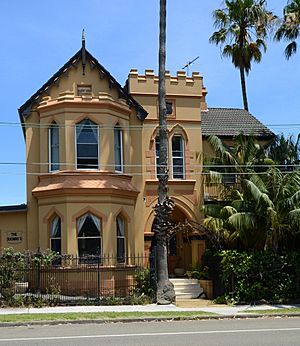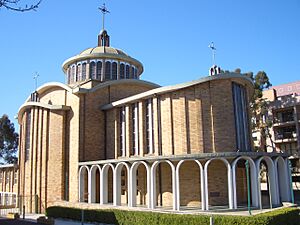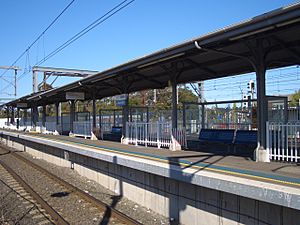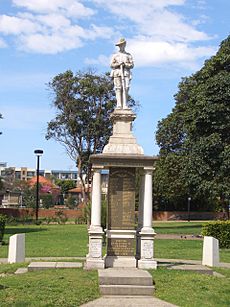Lidcombe facts for kids
Quick facts for kids LidcombeSydney, New South Wales |
|||||||||||||||
|---|---|---|---|---|---|---|---|---|---|---|---|---|---|---|---|
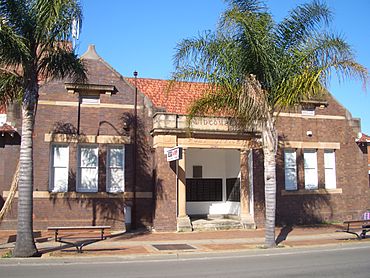
Former Lidcombe Post Office, Joseph Street
|
|||||||||||||||
| Population | 21,197 (2021 census) | ||||||||||||||
| • Density | 3,117/km2 (8,070/sq mi) | ||||||||||||||
| Postcode(s) | 2141 | ||||||||||||||
| Elevation | 19 m (62 ft) | ||||||||||||||
| Area | 6.8 km2 (2.6 sq mi) | ||||||||||||||
| Location | 15 km (9 mi) west of Sydney CBD | ||||||||||||||
| LGA(s) |
|
||||||||||||||
| State electorate(s) | Auburn | ||||||||||||||
| Federal Division(s) | |||||||||||||||
|
|||||||||||||||
Lidcombe is a lively suburb in western Sydney, New South Wales, Australia. It's located about 15 km (9.32 mi) west of the main city centre. Most of Lidcombe is part of the Cumberland Council area. A smaller industrial part in the north belongs to the City of Parramatta. The postcode for Lidcombe is 2141, which it shares with Berala.
Contents
Who Lives in Lidcombe?
Lidcombe is a very diverse place! The 2021 Census counted 21,197 people living here. About 30.6% of residents were born in Australia. Many people have come from other countries. The most common birthplaces after Australia were South Korea (14.4%), China (11.1%), Nepal (7.0%), Vietnam (5.7%), and the Philippines (2.8%).
People in Lidcombe speak many languages at home. While 19.5% speak only English, others speak Korean (16.8%), Mandarin (12.1%), Cantonese (9.3%), Nepali (6.8%), and Arabic (3.8%). When it comes to religion, many people reported having no religion (27.4%). Other common religions include Catholic (17.2%), Hinduism (10.5%), and Buddhism (9.7%).
Lidcombe used to be known as a working-class suburb. But over the last ten years, it has changed a lot. This process, called gentrification, means the area has become more modern and attractive. Today, Lidcombe is a truly global suburb, showing how many different people have moved to Australia over the years. It has a large Korean community, with many Korean restaurants, cafes, and shops.
Lidcombe's Past
The history of Lidcombe goes back to the early 1800s. Samuel Haslam owned land near Haslams Creek from 1804. In 1859, a railway station called Haslam's Creek opened here. It was on the train line connecting Sydney to Parramatta. Even though a station wasn't planned, local landowners paid to have it built.
Haslam's Creek was also the site of New South Wales' first railway accident in July 1858. Sadly, two people died in this event.
After World War II, many European migrants came to Lidcombe. A large number of Ukrainians settled here. They built churches, halls, and schools. Lidcombe is still an important cultural hub for the Ukrainian community in Sydney. Later, in the 1960s and 1970s, more people from the Middle East moved to the area.
The two main streets in Lidcombe are John and Joseph Streets. They are named after an early priest, John Joseph Therry.
Changes to the Suburb's Borders
In 1989, an industrial area in the north, near Homebush Bay, became its own suburb called "Homebush Bay." This area was chosen to host the 2000 Summer Olympics. In 2009, it was renamed Sydney Olympic Park. A small part of it became a new suburb called Wentworth Point. At the same time, a small industrial part of Sydney Olympic Park, around Carter Street, was returned to Lidcombe.
In 2016, the local council, Auburn Council, was closed down. Most of Lidcombe then became part of the new Cumberland Council. The small industrial area that was once part of Sydney Olympic Park became part of the City of Parramatta.
Historic Places
Lidcombe has several places that are important for their history. These are called heritage-listed sites:
- East Street: Rookwood Cemetery and Necropolis
- Joseph Street: Lidcombe Hospital Precinct
Important Landmarks
Lidcombe has many interesting buildings and places:
- North of the railway line:
* Church Street is home to St Andrew's Ukrainian Catholic Church. It also has a presbytery (where the priest lives), a hall, a school, and a kindergarten. * John Street has the Ukrainian Youth Association's Centre and the Armenian Catholic Church.
- South of the railway line:
* Joseph Street is where you'll find the Ukrainian National Hall and the Ukrainian Central School. Nearby is the office for "The Free Thought" Ukrainian newspaper. * The Railway Hotel is an Art Deco building on Joseph Street. It is listed as a State heritage site. * The Lidcombe Hotel on John Street and the Royal Oak Hotel on Railway Street are also heritage-listed. * The Gables is a historic house on East Street. It's now used for special events and is also a State heritage site. * The Juniperina Juvenile Justice Centre on Rookwood Road is a special facility for girls who need support from the justice system. It's the only one of its kind for young female offenders in New South Wales. * Lidcombe Hospital closed in the 1990s and is now a residential area. The original buildings were designed in 1906 and are listed as important heritage sites. * The former Lidcombe Post Office on Joseph Street is also a heritage-listed building.
Places of Worship
Lidcombe is home to many different churches and places of worship, showing its diverse community:
- Sydney Grace Church on 74 Joseph Street
- St Joachim's Catholic Church on John Street and Mills Street
- Sts Cyril and Methodius Slovak Catholic Church in Vaughan Street
- St Andrew's Ukrainian Catholic Church (with a Byzantine style) on Church Street
- St Stephens Anglican Church on Mark Street
- The Slavic Evangelical Pentecostal Church on 5 Matthew Road
- Lidcombe Gospel Hall on 2 Neville Street
- Russian Orthodox Old Rite Church on Vaughan Street
- St Ephraim Syrian Orthodox Church on Joseph Street
- Lidcombe Baptist Church on Kerrs Road
- Our Lady of the Assumption Armenian Catholic Church on John Street
- Pacific Island Christian Church on Martin Street
- Christian Church on the corner of Olympic Drive and Vaughan Street
- GracePoint Presbyterian Church on the corner of East and James Street
- Onnurri Korean Church in the Botanica Estate on Main Avenue
- Granville Community Church on Good Street
Schools in Lidcombe
Lidcombe has several schools that help educate the local children.
Lidcombe Public School
Lidcombe Public School, on John Street, opened in 1879. It has about 600 students from the Lidcombe area. The school also helps children with special education needs. They have trained teachers for this. Students can join a choir, dance group, or sports teams. There is also a program for before and after-school care. Buses 925 and 920 provide transport to and from the school.
St Joachim's Parish School
St Joachim's Parish School is a Catholic school on Mary Street. The Sisters of St Joseph started the school in 1885. They taught there until 1984. After that, lay staff (non-nuns) took over. They continue the traditions of Blessed Mary MacKillop, who visited the school. This school teaches children up to Year 6.
Former Marist Brothers School
Marist Brothers was a boys' school on Keating Street. It was located behind St. Joachim's Catholic Church. This school closed when several Catholic schools in the area joined together. The site is now used for various Catholic Church activities. These include an education office and a bookstore.
Shopping and Businesses
Lidcombe has a mix of homes, shops, and industrial areas. The main shopping area is near the train station. Lidcombe Shopping Centre (also known as Lidcombe Power Centre) is a medium-sized shopping centre. It's about 2 km from Lidcombe railway station. The centre has two large stores and around 60 smaller shops.
More shops and businesses are found along Parramatta Road and nearby streets. The area close to the train station is famous for its many restaurants. Most of these offer delicious Korean food.
Local Industries
Lidcombe is home to several important businesses and industries:
- Macquarie Goodman owns business parks on Parramatta Road and Birnie Avenue.
- The Dairy Farmers' distribution centre is on Birnie Avenue. This company supplies milk.
- The Arthur Street business park is near the border with Strathfield.
- Dooley's Lidcombe Catholic Club is a popular club. It has other locations in Silverwater and Regents Park.
- The headquarters of Nick Scali Furniture is here. This company started in 1962 and now has furniture shops all over Australia.
- The Tooheys Brewery is on the corner of Parramatta Road and Nyrang Street. This brewery was bought in 1955. It is now part of the Lion Nathan company. You can often smell the hops (used to make beer) in the air, especially at night!
- The NSW Rural Fire Service headquarters used to be on Carter Street. It has now moved to Murray Rose Ave in Sydney Olympic Park. Carter Street was part of Lidcombe before the 2000 Sydney Olympics.
Getting Around Lidcombe
Trains
Lidcombe railway station is a very important train station. Many train lines meet here:
- The Olympic Park line goes to Sydney Olympic Park.
- The North Shore & Western Line goes east to Berowra or Hornsby (through the city). It goes west to Richmond or Emu Plains (through Parramatta).
- The Inner West & Leppington Line goes east to the City (through Strathfield). It goes west to Leppington (through Granville).
- The Bankstown line goes to the City (through Bankstown).
Some longer-distance trains on the Blue Mountains railway line also stop at Lidcombe.
A special train service used to run from the Mortuary railway station near Central Station. It went to a platform at the nearby Rookwood Cemetery on the Rookwood Cemetery railway line. This service has now closed.
Bus Services
Several bus companies run routes through Lidcombe station. Transit Systems operates one route. Transdev NSW runs three routes. NightRide also has three routes that pass through Lidcombe station. You can find more details about these services at Lidcombe Station.
Sports and Fun
Lidcombe Oval
Lidcombe Oval is a sports ground on Church Street. It's on the north side of the railway line. From 1967 to 1986, it was the home ground for the Western Suburbs Magpies rugby league team. A cycling track goes around the playing field. The ground was known for being a tough place for visiting teams to win. Especially in the late 1970s and early 1980s, when the Magpies were very strong. Games against rivals like Parramatta Eels and Manly-Warringah Sea Eagles often drew huge crowds. The record attendance for the venue is 21,015 people! This was for a game between Wests and Parramatta on July 30, 1978.
Carnarvon Golf Course
Carnarvon Golf Course is located at Nottinghill Road and Joseph Street. It has an interesting history! The first golf course was used from 1927 to 1932. It was in an area now covered by the M4 Western Motorway. The "Old Course" was used from 1932 until 1943. Part of it was taken over by the U.S. Navy during World War II. A different nine-hole course was used from 1942 to 1949. The current golf course opened in December 1949. It was built on land that used to be the Lidcombe Sports and Showground.
Ruth Everuss Aquatic Centre
The Ruth Everuss Aquatic Centre (formerly Auburn Swim Centre) is on Church Street. It has both indoor and outdoor swimming pools. The centre was closed for big renovations and reopened in 2017. It is named after Ruth Everuss, an Australian Olympic swimmer. She was part of the silver medal-winning women's 4 × 100 m freestyle relay team at the 1960 Summer Olympics in Rome.
Famous People from Lidcombe
- Naazmi Johnston (born 1988): An Olympic and Commonwealth gymnast. She represented Australia at the 2008 Olympic Games and the 2006 and 2010 Commonwealth Games.
- Rod Taylor (1930–2015): A famous actor from Hollywood. His mother lived in a local street for many years after he became successful. He went to Parramatta High School.
- Michael Wenden (born 1949): An Olympic swimmer. He attended Marist Brothers Lidcombe. He won two gold medals (100 m and 200 m freestyle), a silver medal, and a bronze medal at the 1968 Mexico City Olympics.


